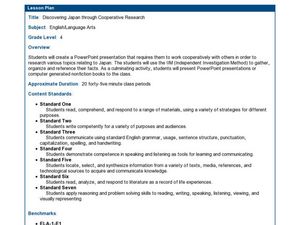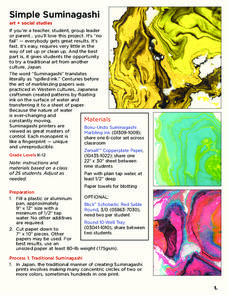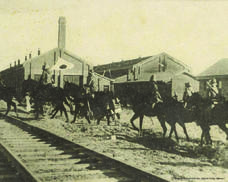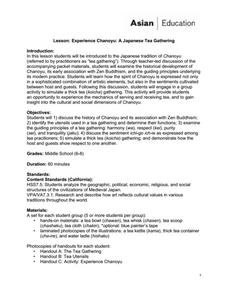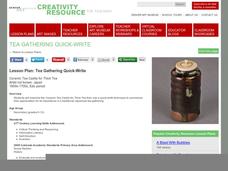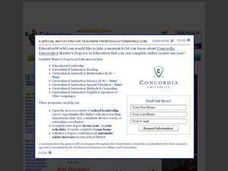Curated OER
Lesson Plan: The Tour Starts at Noon
The Eleven-Headed Bodhisattva is a piece that represents characteristics, meanings, and ideals common to those who practice Buddhism in Japan. Learners fully analyze this piece, then take a virtual trip to examine the Buddhist...
Curated OER
Japanese Tea and Teacups
Upper graders use the potter's wheel to make Japanese style tea cups, which they will use in a Japanese style tea ceremony. They hone their sculpting techniques while exploring Japanese cultural and the history of tea. There are two...
Curated OER
Add a Little Art to Your Math
Origami presents a beautiful way to express and test geometric and algebraic concepts.
Curated OER
Discovering Japan Through Cooperative Research
Search a variety of sources to create a multimedia or book project about Japan. Learners use the independent investigation method to plan and conduct research about Japan. They use the information they discover to create a computer book...
Curated OER
Simple Suminagashi
What a wonderful way to meld art and culture! Learners create art work in the Suminagashi style using this detailed lesson plan. This art form, which is Japanese in origin, employs ink to create beautiful results. This will be a hit with...
Center for History Education
Japanese American Internment During World War II
World War II turned nations against each other and neighbors into enemies. An eye-opening activity explores the dark past of Japanese-American internment camps during WWII. Scholars learn of the fear and distrust toward Asian Americans...
Stanford University
Japan and America
When Commodore Matthew Perry sailed to Japan and demonstrated American naval strength, he forced the empire to engage in trade with the United States. How did this new, strong-armed relationship influence both parties? Pupils consider...
National WWII Museum
Strategic Decision Making in the Pacific Scenarios
Individuals decide what they would do when faced with a difficult military decision that puts others' safety in jeopardy. The lesson also gives the real-life outcomes of the scenarios that occurred during World War II to give them a...
National WWII Museum
Picturing the War in the Pacific Photos, Datelines and Captions
Young historians have the opportunity to see photos from the war in the Pacific and learn more about what each photo represents. Scholars use their knowledge of WWII to match dates and descriptions to real-life photos from the war. The...
US National Archives
WWII: The Pacific 1939-45 – Japan and the Atom Bomb
Though the scientists who developed the atom bomb did not believe it should be used to end World War II, American President Harry S. Truman and British Prime Minister Winston Churchill were of like mind in their decision to drop the bomb...
US National Archives
WWII: The Pacific 1939-45 – Iwo Jima
Of the images that have permeated history to define American courage, perseverance, and patriotism, the 1945 photograph of United States Marines raising the flag at Iwo Jima is one of the most well known. After researching the pivotal...
US National Archives
WWII: The Pacific 1939-45 – Pearl Harbor
Though December 7th, 1941 was a day "which would live in infamy," World War II had provided many infamous days, events, battles, and atrocities in the years before. So why were American forces so surprised when Japan attacked Pearl...
Asian Art Museum
Experience Chanoyu: A Japanese Tea Gathering
As part of the study of Japanese cultural history, introduce your class members to Chanoyu, the Way of Tea. After a discussion of the history and key elements of Chanoyu, class groups perform the ceremony.
Japan Society
The Bubble Economy and the Lost Decade
Explore Japanese society and national identity. Class members share ideas about the Japanese economy and then investigate a series of resources, including an article, a film, a lecture, and a poem, to learn about Japan's Bubble Economy...
Denver Art Museum
Tea Gathering Quick-Write
Japanese tea gatherings are the inspiration for a great lesson plan. Learners are provided with an image of a tea caddy made for thick tea and asked to describe what they notice and what that might mean. This leads into a larger lesson...
Curated OER
Act it Out: Dramatizing Asian American Stories
Read and act out folktales, fairy tales, or myths from various Asian American cultures with your class. Each group reads a story aloud and then works together to create a short play or skit about the story. Suggestions for stories are...
Curated OER
Lesson: The Significance of Symbols in Japan
A fabulous Samurai suit of armor is the inspiratoin for a creative reseach project and presentation. Kids research the symbols found on the Samurai armor, describing the symbols meaning or significance in Japanses culture.
Curated OER
Developing Writing Skills Through Japanese Folk Music
Students listen to Japanese folk songs to get inspired to create a writing piece about Japan. In this writing lesson, students use primary and secondary sources to add information about Japan.
Curated OER
What's In a Name?
Students explore the relationship between names and certain cultures and locations. In this identity lesson, students create family migration or immigration maps. Students read excerpts from When My Name was Keoko and Lost Names: Scenes...
Curated OER
Carp Streamer
Learners use the internet to research Children's Day in Japan. In groups, they examine the symbols on the streamers placed outside of families homes. To end the lesson plan, they design their own carp streamers and hang it from the...
Curated OER
Lesson: Creating With A Purpose
Discovering the creative process can be done through critical analysis. Upper graders examine a hand -carved Shinto Deity, discussing purpose, technique, and artistic expression. They then read a poem about the creative process. and...
Curated OER
Japanese Festivals and Holidays
Bring the excitement and beauty of Japanese festivals into your classroom. Kids with special needs create calendars that reflect special festivals and holidays common to Japanese culture. They start the project by creating a list of...
Curated OER
Oh, What A Day
Young scholars listen as the teacher reads A Country Far Away. They predict what they will do and what they think their partner student will be doing. Students create a KWL chart for Japan. They collect information about their activities...
Curated OER
Paper Cranes
Paper folding is a great art form that can be incorporated into cultural, mathematic, and art lessons. This resource includes the full instructions needed to fold a paper crane, as well as a Haiku poetry idea. Tip: This activity would be...





